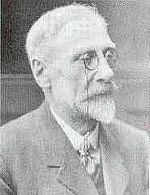
Alfred Watkins
In simple terms, a Ley Line is an imaginary straight line passing through a number of ancient sites such as earthworks, barrows, mounds and tumuli, standing stones, stone circles, and so on. Possibly because Christian churches were sometimes built on the sites of older, pagan, sacred places, churches also commonly appear on Ley Lines. Other items often found on Ley Lines include boulders, cairns and other mark stones of various kinds, and moats or ponds.
Although the subject has now been embraced by members of the UFO community and other believers in paranormal phenomena, Watkins himself simply suggested that they were very ancient track ways leading from one important place to another, and used by prehistoric Man for easier travel, perhaps while transporting heavy loads, by the most direct route - a straight line. In those early times, just as nowadays, a reliable method of navigating would have been very important for travellers. An inadvertent deviation from the most direct route could add a considerable amount of distance and time to a journey, especially for a heavily laden traveller on foot. With dangerous wild animals still at large, including wolves until relatively recently, any extra time spent travelling would add extra danger to the journey, and provisions carried would perhaps run short if the journey was longer than expected.
It is easy to find lines that may or may not be Ley Lines on any large scale Ordnance Survey or similar map. Locate two churches or ancient monuments near opposite edges of the map, then place a ruler or a length of cotton pulled taut between the two points. It is quite likely that another church will appear somewhere on the same line. If not, try a different pair of churches, and eventually you should find a line, possibly with several churches or ancient monuments on it. You really need to find a line with at least four alignments to avoid the possibility that it is just a result of pure chance. It's a great feeling when you find your first 'Ley Line'. The problem is, as many people will be quick to point out, that you might well get the same results if you searched for lines of public houses, or Post Offices, or perhaps even supermarkets nowadays, so one should not be too quick to jump to conclusions. On the other hand, for obvious reasons, public houses would naturally have been built along the routes used by travellers, although the ancient trackways would by then have been largely replaced by roads and lanes following roughly the original lines. The fact that public houses could form lines is therefore not conclusive proof that those lines are not Ley Lines.
There is little to argue with in Watkins' original idea, in my opinion. His meticulous studies of a number of ancient sites are fully explained in his book, with several diagrams and photographs as evidence. He suggests that by using very simple tools such as sighting rods, people in ancient times would plot the straightest route across a particular area, marking the intermediate points with rocks or mounds that the traveller could navigate by. Even natural features of the landscape such as hills, or prominent notches in them, appear to have been incorporated into Ley Lines in some instances. While there is no definite, hard evidence of how the lines were set up, or even if they were deliberately set up in the first place, there is certainly no reason to suggest that it would have been in any way impossible. Some of the standing stones are carved or worked in some way, but again that was within the capability of the ancient peoples.
In more recent times there have been various suggestions that Ley Lines are lines of some form of energy circling the Earth, with the intersections of lines being areas of higher energy. There are also suggestions that UFOs are in some way associated with Ley Lines, as there have been many reports of strange objects being seen near major Ley Lines and ancient monuments such as Stonehenge. Believers in these theories feel that, rather than creating the Ley Lines themselves, the ancient people, being simpler and closer to the Earth than modern man, were able in some way to sense the power, and therefore able to mark the areas of greatest power, using rocks and mounds as mentioned earlier. In other words, the same people created, or at least marked the lines, but for a completely different reason.
While the more dramatic claims about Ley Lines being 'Lines of Energy' and suchlike may eventually prove to have some basis in fact, there is as yet no conclusive proof of the idea as far as I am aware. My personal opinion is that Ley Lines, despite being imaginary lines, are in a way tangible, given the physical presence of the standing stones, mounds and other markers, and therefore are real. UFOs, on the other hand, remain very much like elusive phantoms, always just slightly out of reach, with little hard evidence of their existence. In the final analysis, I am not convinced that the two are linked.
I must stress that I am not claiming that UFOs do not exist. Many very intelligent people are fully convinced that UFOs are real, and I have absolutely no evidence proving otherwise, nor would I wish to try to prove otherwise. Any argument against the existence of UFOs could in fact equally be levelled against the existence of God. Neither has so far been proved beyond doubt, with hard evidence. We should always bear in mind that many previously unbelievable ideas have become proven facts in recent years, so perhaps it would be wise to keep an open mind on the possible link between Ley Lines and UFOs, and other improbable sounding theories. They may not be quite as improbable as we think they are....

Ley Lines and UFOs - are they linked?
